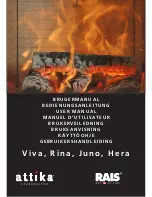
© 2007-2008 Broseley Fires Ltd
4A
THE
PRIMARY
AIR
CONTROL
(lever
B)
The
primary
air
control
is
found
to
the
right
of
the
main
door
(‘B’
in
the
attached
diagram),
it
is
in
the
style
of
a
push/pull
lever.
This
control
will
be
used
during
the
initial
lighting
phase.
The
ash
drawer
must
be
regularly
emptied,
so
that
the
ash
does
not
obstruct
the
entry
of
primary
air.
The
chamber
in
which
the
drawer
is
housed
will
also
need
to
be
cleaned
on
a
regular
basis,
as
any
ash
that
spills
over
the
sides
of
the
pan
will
get
pushed
to
the
rear
of
the
chamber
and
interfere
with
the
thermostat
control
damper.
Failure
to
keep
this
area
clear
will
result
in
the
damper
being
stuck
in
the
open
position.
4B
SECONDARY
AIR
CONTROL
(slider)
Over
the
hearth
door
you
will
find
the
‘secondary
air
control’
in
the
style
of
a
slider.
(‘A’
in
the
attached
diagram)
Combustion
air
entering
the
stove
through
this
vent
will
be
directed
down
the
inside
of
the
glass
panel,
this
is
known
as
the
‘air
wash
system’.
It
helps
to
keep
sooty
deposits
from
sticking
to
the
glass
and
obscuring
the
view
of
the
flames.
Having
clean
glass
also
improves
the
heat
radiation
to
be
uninterrupted.
This
control
will
be
used
to
adjust
the
combustion
rate
inside
the
fire
chamber.
4C
THE
THERMOSTAT
CONTROL
(lever)
The
thermostat
control
can
be
found
at
the
rear
of
the
stove
on
the
right
hand
side,
it
is
situated
above
the
direct
flue
path
shutter
control
(see
below
for
position
of
flue
path
shutter)
The
thermostat
control
operates
a
damper
that
allows
air
to
enter
the
stove
at
a
controlled
rate.
It
regulates
the
burn
rate
of
the
fire
and
keeps
it
at
a
constant
heat
output,
irrespective
of
the
fuel
load
(so
long
as
it
isn’t
empty)
When
wanting
to
control
the
stove
using
the
thermostatic
control,
the
primary
and
secondary
air
controls
can
be
shut.
According
to
the
chosen
position
of
the
thermostat
dial,
the
damper
will
react
slowly
and
alter
the
combustible
air
entering
the
unit.
This
is
how
a
fire
would
naturally
respond
to
changing
air
supply.
As
it
is
a
high
precision
device
we
recommend
moving
the
lever
slowly
and
with
care
and
never
forcing
it.
The
thermostat
control
must
not
be
used
to
build
the
fire
up
suddenly
and
then
shut
it
down
suddenly.
This
is
of
no
benefit
and
may
cause
serious
damage
to
the
internal
components
of
the
appliance
or
control.
D


































